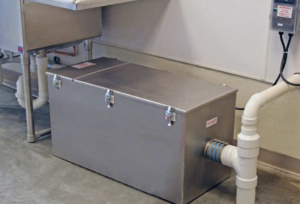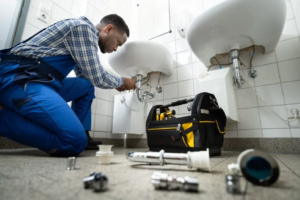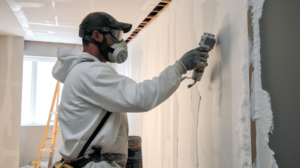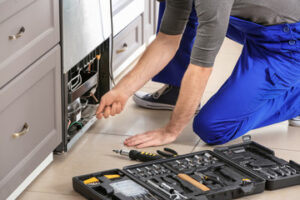Grease Trap Perth and interceptors are essential in any food service establishment. Whether you are running a restaurant, mall or hospital, they help prevent messy sewage backups that can result in costly fines and downtime.
Regular cleanings and pumping of your grease trap is crucial. Using an enzyme product to break down FOGs helps with this process.

A grease trap is a receptacle through which kitchen wastewater flows before entering a sewer waste system. The purpose of the device is to intercept, or “trap,” fats, oils, and greases (FOG) so they can’t gum up drain lines and cause clogs. It’s important for facilities like restaurants, bakeries, schools, and bars to have a grease trap because it allows them to avoid costly plumbing problems.
Most towns and cities have laws requiring food service establishments to install and regularly maintain grease traps. Often, these regulations also include inspections of the facility to ensure that the trap is being properly maintained. The longer the time between cleanings, the higher the risk of a FOG build-up that will ultimately require the trap to be removed and replaced.
Grease traps are typically made of stainless steel and can be installed outside, above ground, underground, or inside the facility. There are a few different types of traps, but they all perform the same basic function: reducing the amount of FOG that enters the sewer system.
Traps are designed with two chambers: the first collects FOG and solids while the second drains clean water into the sanitary sewer system. Solid food scraps sink to the bottom of the trap while lighter grease and oil float to the top, separating the dirty wastewater from the clean water. The trapped grease is then pumped out on a regular basis, usually by a professional grease management company.
There are three main kinds of grease traps: passive hydromechanical, automatic, and gravity interceptors. Passive and automatic traps contain baffle walls that help maximize separation between the chambers, while gravity systems are larger in-ground tanks with internal baffles that work similarly to passive hydromechanical traps. All of these grease traps are designed to reduce the number of FOGs that enter the sewer system while allowing them to be pumped out on a regular basis.
The waste pumped from grease traps and interceptors is often called brown grease because it consists of a mixture of cooled, dissolved, and solidified FOG. The brown grease is often used as fuel in biodiesel production and can be recycled.
How Does a Grease Trap Work?
A grease trap is a small FOG removal unit installed underneath sinks within kitchen facilities. It works by slowing down wastewater flow and allowing it to cool, which separates the fats, oils, and grease from solid food waste and debris. Because the FOG is lighter than water, it floats to the top of the trap where it collects, leaving only clean wastewater to exit through an outlet fitting and into the sanitary sewer or septic system. The trap can also have internal baffle walls to increase the separation efficiency, reduce blockages, and make it easier to pump out the trap contents for disposal.
Grease traps are commonly used by restaurants, hotels, cafeterias, bakeries, schools, and bars that produce large quantities of FOG in their kitchens. Many cities require these kinds of commercial kitchens to install grease traps to protect the sewage systems from FOG-related blockages.
A full-service septic company should offer both installation and regular grease trap maintenance to keep commercial kitchens running smoothly and efficiently. A quality grease trap should be sized to meet the facility’s wastewater volume and production rates, which will help prevent overflows and clogs. It’s important to regularly check and empty the trap as needed, too.
Keeping up with routine grease trap cleaning can also prevent a FOG buildup that could potentially overflow the drain and into a restaurant’s plumbing systems. It’s important to have a comprehensive plan in place to manage restaurant grease properly and comply with government regulations.
It’s important to educate staff on the proper disposal methods for FOG and other items that shouldn’t go down the drain. This includes using designated grease disposal containers, scraping dishes thoroughly before washing them, and using strainers in sink drains to catch larger pieces of food waste. Regular reminders and posted guidelines are also helpful in encouraging these practices.
While educating staff and ensuring the grease trap is properly sized and maintained can go a long way to preventing clogs, some grease will still build up over time. That’s why it’s important to hire a trusted professional for regular maintenance services. A reputable service will know how often to pump the grease trap and will inspect it for signs of clogs or other problems. They can also provide a range of other plumbing services, such as hydro jetting and using fiber optic cameras on ropes to find clogs in pipes.
https://www.septictankarmadale.com.au/
(08) 6117 5752
18 Brumby Pl, Armadale WA 6112, Australia
How Long Does a Grease Trap Last?
Whether you use a passive hydromechanical grease trap, an automatic grease interceptor or a gravity grease trap, the trap must be cleaned and pumped regularly. This helps to prevent the build-up of FOG in internal piping, and it can also reduce fire hazards in your restaurant kitchen. The frequency of cleaning and pump-outs depends on the size of the trap, seating capacity and cooking techniques employed. However, most local wastewater authorities recommend a trap cleaning schedule of every 1-3 months, depending on usage.
Often, restaurants won’t realize their trap is due for a pump-out until it is almost too late. That is why it is important to keep up with a maintenance schedule, and have a third-party service company perform regular inspections. This will help you avoid the costly pitfalls of failing to maintain your grease trap, such as clogged drain lines and expensive plumbing repairs.
When your trap is full, it can begin to smell and may even affect sink drainage. Fortunately, there are a few signs that can help you to know when it is time to clean or pump your grease trap. One simple rule to remember is the “1/4th Rule,” which suggests that your trap should be pumped out when it is a quarter of the way full of FOGs. It is important to pump your grease traps before they reach this point, as more than a quarter full can lead to inefficiency and unpleasant odors.
Once a trap is pumped, it must be rinsed out. This can be done manually or with a chemical treatment solution. The chemical solution combines non-pathogenic bacteria with nutrients and enzymes to break down FOG, aiding grease trap performance. It is also recommended that a biodegradable lubricant be added to the pumped-out grease trap to aid in the transfer of FOG into the sewer system.
Failing to maintain your grease traps can be extremely dangerous for customers and staff members, as well as for the surrounding environment. A poorly maintained trap can lead to clogged drains, fire hazards and costly plumbing repair. Fortunately, it is easy to prevent these issues with regular maintenance and by following local regulations.
What Are the Signs of a Grease Trap Blockage?
Keeping your restaurant’s grease traps in tip-top shape is important to avoid unpleasant odors, slow drainage and costly repair bills. It also helps to maintain your kitchen’s efficiency and keep your business compliant with local environmental regulations. Grease traps play a key role in separating fats, oils and greases (FOG) from wastewater before it enters the sewer system. Restaurants, hotels and other commercial kitchens rely on them to prevent sewage blockages and ensure that food waste is safely and adequately disposed of.
However, it is easy to forget or ignore the condition of your grease trap when you’re busy running a business. If you’re not aware of how to spot a grease trap problem, it can lead to unpleasant odors in your kitchen, clogged drains and even expensive repairs and fines from the local authorities.
A foul odor in your kitchen is one of the most obvious signs that it’s time for grease trap cleaning. The foul odor comes from oil, grease and food solids that build up and decompose in your grease trap over time. When these materials make their way into the sewer system, they can cause sanitary sewer overflows (SSO) which pose a public health risk and are very difficult to clean up.
Another clear sign of a grease trap problem is slow-draining water, which indicates that the trap is full or clogged. A clogged grease trap can’t hold more FOG, so the excess is forced to find other ways to escape. This can result in clogged sinks, sewer pipes and other problems that are very difficult to clean up.
If your grease trap is overflowing, it’s time to get it cleaned and pumped out. Overflowing grease traps can back up into your kitchen, or may escape out the manhole cover outside. This is a serious issue that requires immediate attention from a plumber to avoid costly sanitation and plumbing damage.
If you’re not sure when your grease trap was last cleaned, or if you need to schedule a cleaning service, check the dates on your calendar and mark them off as they come up. It’s a good idea to have your grease trap cleaned every 90 days or less. The more often it is cleaned, the more efficient and hygienic your kitchen will be.


